|
|
|
| |
Ibike
Korea People-to-People Program
|
|
|
|
|
| |
|
 Photo essay: Gyeongju to
Cheongdo Photo essay: Gyeongju to
Cheongdo
|
| |
|
(80km, 50mi) We
ride out of the city into farm and valletys.
Points of interest: Tombs, temples, graves, pavilions, heritage houses, shines,
lakes, rivers, farm valleys, mountains |
| |

|
Tomb of General Kim Yu-sin (595~673):
Gen Kim was the great grandson of Guhyeongwang, the last king of Geumgwangaya.
He was a member of hwarang, the elite youth military corps, at age fifteen. Gen.
Kim is considered the greatest Silla military leader and was the man who unified
the three ancient Korean kingdoms. |
| |
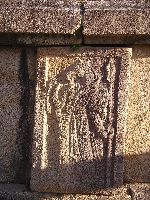
|
Tomb of General Kim Yu-sin Zodiac
figure: The bottom of the tomb is encircled by 1.2m high stone panels on which
the twelve zodiac animals are carved. The serve to protect the area.
The tomb is 18m in diameter and 5.3m high. |
| |
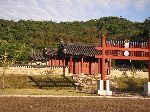
|
Sungmujeon Shrine: the mortuary
tablet of Heungmu Daewang (a.k.a. Gen. Kim Yu-sin) is enshrined here.
In 660, Gen Kim helped Taejong Muyeolwang annex Baekje to Silla, and in 668, he
helped Munmuwang annex Goguryeo. After that he drove Chinese Tang forces
from the Korean peninsula. |
| |
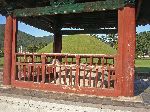
|
This tortoise-shaped stone base (Gwibu)
is for a monument for Kim In-mun (629~694). The tablet and the capstone
are missing. Kim In-Mun was the 2nd son of King Taejong Muyeol, the 29th
king of Silla, and made a great contribution to the unification of the Three
Kingdoms. In the 7th century tortoise-shaped stone bases made a
transformation to dragon head shapes. Near by is the royal tomb of Taejong
Muyeolwang (r 654~661), the king who laid the foundation for the unification of
the Three Kingdoms. |
| |
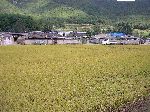 |
Towns and villages are compact and end
abruptly in farm land. Autumn is a particularly pretty time because the
rice is ripening and various shades from green to golden. |
| |

|
Construction of Expressway #1. On one side of
the valley it pops out of the hillside. To the left of the picture it
dives back into the hillside on the other side of this narrow valley. |
| |
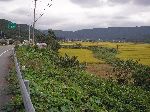
|
Cloudy sky just added more richness to the
landscape. Though this was at the tail end of what could be a rainy
season, we never got more than a light mist on a couple of occasion. It is
great cycling weather. |
| |
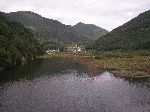
|
The hills add to the texture of the landscape, and
fortunately the road mostly followed the valley floor here so there were many pleasant miles
of travel. |
| |
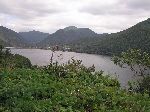
|
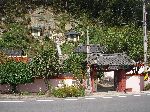 In Buddhist tradition, an
auspicious location for meditation has a mountain
to your back and water to your front. There
were miles and miles of the route well suited for "motion meditation" and
general good inspiration. Along the way there were small tranquil fixed
temples (right) as well, for those who prefer more traditional settings for
meditation. In Buddhist tradition, an
auspicious location for meditation has a mountain
to your back and water to your front. There
were miles and miles of the route well suited for "motion meditation" and
general good inspiration. Along the way there were small tranquil fixed
temples (right) as well, for those who prefer more traditional settings for
meditation. |
| |
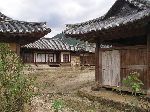
|
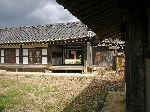 Heritage houses of Sinji-ri.
This house was built in 1809 and repaired on a large scale in 1824 and 1905.
Because the house are within the Busan Perimeter, they escaped damage during the
Korean Civil War. Thee Seung-man, the first president of the Republic of
Korea, stayed here during the civil war. Heritage houses of Sinji-ri.
This house was built in 1809 and repaired on a large scale in 1824 and 1905.
Because the house are within the Busan Perimeter, they escaped damage during the
Korean Civil War. Thee Seung-man, the first president of the Republic of
Korea, stayed here during the civil war. |
| |
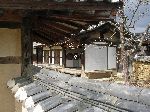
|
This heritage house, "Doilgotaek", was built in
1899. The men's living quarters with octagonal windows stands near the
main gate. On the left and right of the inner courtyard are a barn and a
separate house. This layout is typical in the Yeongnam area. |
| |
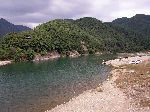
|
There is a small temple on the hillside to the
right and men pass the afternoon fishing from the river bank. |
| |
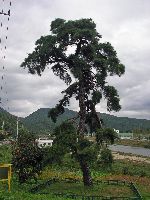
|
Weeping red pine: This tree is also called
willow-like pine tree, because its branches droop like the weeping willow.
Legend has it that this tree, when a minister passed by it suddenly drooped as
if bowing down to him. The tree is presumed to be about 200 years old. |
| |
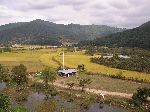
|
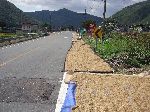 Like retail, most of the agriculture is small size
family farms. This makes agricultural areas very broken up and gives them
lost of texture, color, rhythm and diversity. A definite sign of low
traffic volumes is rice drying on the side of the road. Like retail, most of the agriculture is small size
family farms. This makes agricultural areas very broken up and gives them
lost of texture, color, rhythm and diversity. A definite sign of low
traffic volumes is rice drying on the side of the road. |
| |
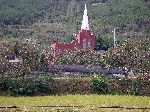
|
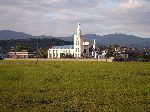 It seems to be generally accepted
that 40% of South Koreans are Christians, 40% are Buddhist and the other 20% are
unaffiliated. Overlaying all of this is a Confucius philosophy. It seems to be generally accepted
that 40% of South Koreans are Christians, 40% are Buddhist and the other 20% are
unaffiliated. Overlaying all of this is a Confucius philosophy. |
| |
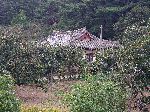
|
Persimmon orchard. We were getting into
persimmon country at near the peak of production. At one farm I was given
a persimmon. This was also the pattern for the rest of the trip where roasted
corn, apples, pears, sweets, coffee, cookies, pine nuts, and various other
treats were offered, without accepting anything in return. |
| |

|
 A bumper crop of persimmons
seemed to be everyplace. From teams of two to crews of a dozen persimmons
were being sorted and
boxed. A bumper crop of persimmons
seemed to be everyplace. From teams of two to crews of a dozen persimmons
were being sorted and
boxed. |
| |
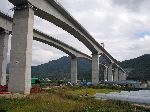
|
Cycling may get even
better on rural roads: Throughout the country there is a huge amount of
construction on express ways. These roads tunnel in onside of a hill and
pop out the other and then float above the valleys in between the mountains.
As they get completed they pull long distance traffic off the old highways
leaving more spaces for cyclists. |
| |
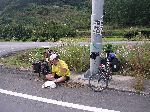
|
Stopping for a snack and check the maps for where
we have been, where we are going, and what we won't be able to see on this trip
and need to come back to checkout. |
| |
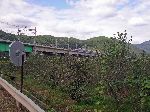
|
An express train zips between cities -- another
element in Koreas "transportation choices" infrastructure. |
| |
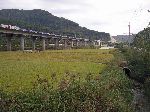
|
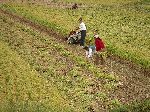 A new expressway (under
construction) hovers over a family rice farm as the family works to cut and
layout the rice to dry. A new expressway (under
construction) hovers over a family rice farm as the family works to cut and
layout the rice to dry. |
| |
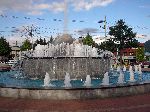
|
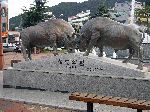 Water
fountain and fighting bulls sculpture in Cheongdo. Cheongdo is a small town with a civic square with a couple of
notable pieces of public art. Water
fountain and fighting bulls sculpture in Cheongdo. Cheongdo is a small town with a civic square with a couple of
notable pieces of public art. |
|
|
|
| |
Gyeongju

 Goryeong Goryeong |
|
    |
 |
|
|
 Please
contact us if you would like to be added to
Ibike's mailing list or have questions, comments, corrections or criticism. (Also, please let us know how you learned about us and
found this site.) Privacy policy. Please
contact us if you would like to be added to
Ibike's mailing list or have questions, comments, corrections or criticism. (Also, please let us know how you learned about us and
found this site.) Privacy policy.
 IBF Homepage
IBF Homepage  Ibike Programs
Ibike Programs
 Ibike Schedule
Ibike Schedule
 Search
Search
"Hosted by
DreamHost - earth friendly web hosting"
Created by David Mozer
Copyright ?1993-2018 Ibike LLC. All rights reserved.
|
 Photo essay: Gyeongju to
Cheongdo
Photo essay: Gyeongju to
Cheongdo








 In Buddhist tradition, an
auspicious location for meditation has a mountain
to your back and water to your front. There
were miles and miles of the route well suited for "motion meditation" and
general good inspiration. Along the way there were small tranquil fixed
temples (right) as well, for those who prefer more traditional settings for
meditation.
In Buddhist tradition, an
auspicious location for meditation has a mountain
to your back and water to your front. There
were miles and miles of the route well suited for "motion meditation" and
general good inspiration. Along the way there were small tranquil fixed
temples (right) as well, for those who prefer more traditional settings for
meditation.
 Heritage houses of Sinji-ri.
This house was built in 1809 and repaired on a large scale in 1824 and 1905.
Because the house are within the Busan Perimeter, they escaped damage during the
Korean Civil War. Thee Seung-man, the first president of the Republic of
Korea, stayed here during the civil war.
Heritage houses of Sinji-ri.
This house was built in 1809 and repaired on a large scale in 1824 and 1905.
Because the house are within the Busan Perimeter, they escaped damage during the
Korean Civil War. Thee Seung-man, the first president of the Republic of
Korea, stayed here during the civil war.



 Like retail, most of the agriculture is small size
family farms. This makes agricultural areas very broken up and gives them
lost of texture, color, rhythm and diversity. A definite sign of low
traffic volumes is rice drying on the side of the road.
Like retail, most of the agriculture is small size
family farms. This makes agricultural areas very broken up and gives them
lost of texture, color, rhythm and diversity. A definite sign of low
traffic volumes is rice drying on the side of the road.
 It seems to be generally accepted
that 40% of South Koreans are Christians, 40% are Buddhist and the other 20% are
unaffiliated. Overlaying all of this is a Confucius philosophy.
It seems to be generally accepted
that 40% of South Koreans are Christians, 40% are Buddhist and the other 20% are
unaffiliated. Overlaying all of this is a Confucius philosophy.

 A bumper crop of persimmons
seemed to be everyplace. From teams of two to crews of a dozen persimmons
were being sorted and
boxed.
A bumper crop of persimmons
seemed to be everyplace. From teams of two to crews of a dozen persimmons
were being sorted and
boxed.



 A new expressway (under
construction) hovers over a family rice farm as the family works to cut and
layout the rice to dry.
A new expressway (under
construction) hovers over a family rice farm as the family works to cut and
layout the rice to dry.
 Water
fountain and fighting bulls sculpture in Cheongdo. Cheongdo is a small town with a civic square with a couple of
notable pieces of public art.
Water
fountain and fighting bulls sculpture in Cheongdo. Cheongdo is a small town with a civic square with a couple of
notable pieces of public art. Please
contact us if you would like to be added to
Ibike's mailing list or have questions, comments, corrections or criticism. (Also, please let us know how you learned about us and
found this site.) Privacy policy.
Please
contact us if you would like to be added to
Ibike's mailing list or have questions, comments, corrections or criticism. (Also, please let us know how you learned about us and
found this site.) Privacy policy.![]() IBF Homepage
IBF Homepage ![]() Ibike Programs
Ibike Programs
![]() Ibike Schedule
Ibike Schedule
![]() Search
Search


